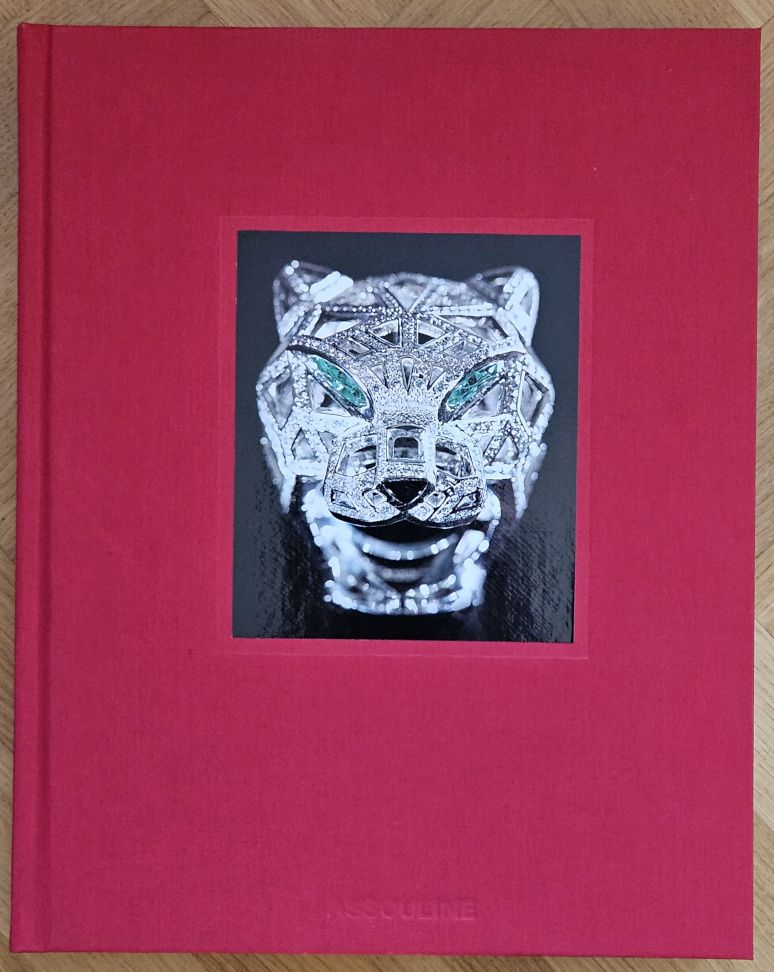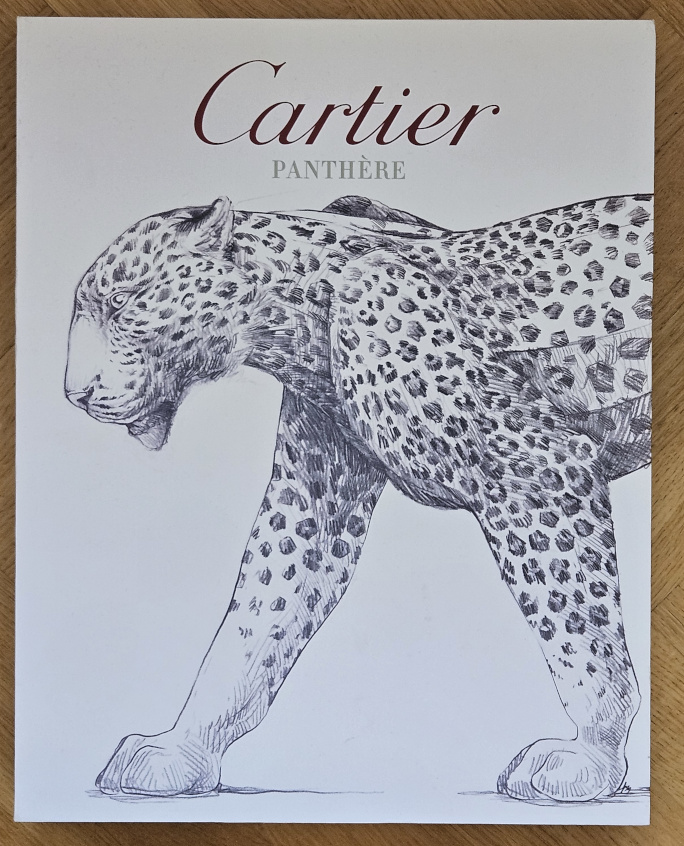The house of Cartier’s homage to their most famous jewellery collection, those of the panther jewels, is a gloriously illustrated book with well-coordinated texts on the theme.
There is no explanation why the jewellery collection is referred to as “Panthere” and not leopard. From a zoological point of view panthers are leopards or jaguars without the classical blond fur with dark spots. In panthers, the spots just became too big and therefore the animal is black. Sometimes, in the sun, one can still see the spots dark brown on black ground. The whole collection of big cat jewels from Cartier is called “Panthere”, if the cats have spots or not. On the slipcase of the coffee-table book we see a drawing of a real, classic leopard from the year 2014. The front cover of the book is the face of a panther in a ring jewel, also from 2014. The reason for calling the whole collection “Panthere” is not lifted in the book, and we just go along with it.
The book has 4 parts, in each of them an accomplished expert of his or her field explains about the “The Panther in Art” (Berenice Geoffrey-Schneiter), “The Evolution of the Cartier Panther” (Vivienne Becker), “Creation of a Cartier Panther” (Joanna Hardy) and “The Panter as Cultural Icon” (Andre Leon Tally).
The most interesting sections for this article are the history of panther jewellery in the house of Cartier and the making of such jewels.
The first big cat jewels from Cartier can be traced to the year 1914, as stated by Vivienne Becker. The idea of creating those jewels was born in 1913. Till 1922 the first collection, including wristwatches, bracelets and vanity cases had been presented. The creator of the first panther jewels was the Cartier jewellery designer Charles Jacqueau.
One of the vanity cases with a panther motive was given by Louis Cartier to Jeanne Toussaint in 1917. She was said to be his lover in the early years, and then became, with time and proven successful track record, his trusted creative director. Her nickname is supposed to have been “La Panthere”. Jeanne Toussaint rose through the ranks of Cartier after starting in 1918 (or 1919) in her first position as a designer for accessories.
After several steps she became the creative director for jewellery in 1933 and stayed in that position till 1970, when she retired at the ripe age of 83. She pushed the creativeness of Cartier, especially on the big cat’s jewellery, to new shores. During the 1950s and 1960s kings, ex kings, royalty, movie stars, café society and anybody who was rich enough wanted Cartier “Panthere” jewels. Household names like the Duchess of Windsor, Elizabeth Taylor, and Maria Felix all wore the whimsical, majestic, and extremely expensive brooches, bracelets, rings, and necklaces that defined the Cartier style.

The creative directors who came after Jeanne Toussaint honoured the spirit of the “Panthere” collection and developed it further. Designs became more wearable and affordable also for non-millionaires, elegant lines without too many diamonds. Designs in gold were quite successful. At the same time, a second line, as unaffordable as ever, is also available to the very rich customers and for us others, to dream about. There is a wonderful commercial video from the year 2011 about the history of Cartier in the light of the “Panthere” collection. It is called “L’Odyssee de Cartier” and one can watch it on youtube. It also gives reference to other famous collections and shows Cartier at its best.
The chapter I liked most in the book is the one written by Joanna Hardy about how the jewels are created. Whilst every finished jewel looks as if it was easy to make, the mosaic patterns of stones in a 3-dimensional design (think of a curled leopard, or a bracelet and a ring etc) are very difficult to implement. There is a beautiful sentence she wrote about the atmosphere in the Cartier workshops (page 169): “Time is not the enemy; instead it slows down to make way for creativity”. Passion and patience are needed by the design team to create the works of art that are their profession.
The authorized book by Cartier about its most famous line of jewels touches important aspects of the company’s history and their future. Ongoing success seems unavoidable. The brand is strong, the jewels beloved and the design range is wide.
The sentiment of humans towards big cats has always been strong and will stay so. Once cats have been hailed as Gods, and inherently we believe they give us strength and elegance. The next volume of Cartier’s “Panthere” book will certainly be published in a few years.
The sentence about time being not the enemy, but the enabler for creativity is one to think about, independently of Cartier. It shows something that has been almost forgotten in out hectic world: Good things take time.
All rights to the book belong to:
(The house of) Cartier: Panthere, 2015, contributors: Berenice Geoffry-Schneiter, Vivienne Becker, Joanna Hardy, Andre Leon Talley, published by Assouline Publishing, 601 West 26th Street, 18th floor, New York, NY 10001, USA, editorial director: Esther Kremer, Creative Director: Camille Dubois, Editor: Amy L. Slingerland, Photo Editor: Hannah Hayden, printed in China, ISBN: 9781614284284

